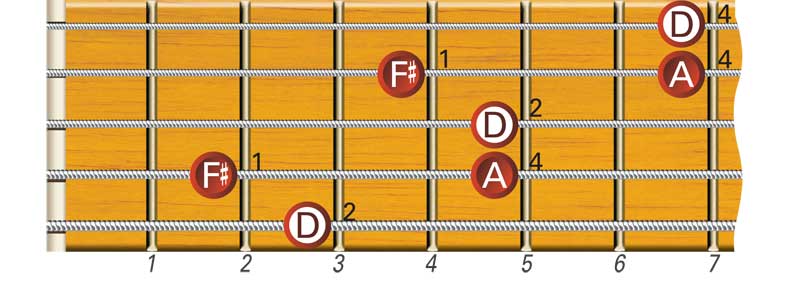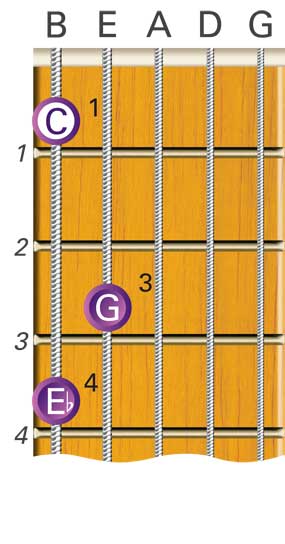
The Major Scale
The major scale is a series of eight notes in alphabetical order that has the familiar sound.

The name of the major scale is taken from its first note (root note).

The notes of the C major scale give the following pattern on the fretboard.

The C major scale over one octave is notated as follows:
The Octave
An octave is the range of eight notes of a major scale. The first note and last note of a major scale always have the same name. In the C major scale the distance from the lowest C to the C note above it is one octave (eight notes).

The C major scale over two octaves has the following pattern on the fretboard.
The C major scale over two octaves is notated as follows.

The following example uses the C major scale over two octaves ascending and descending. In the second higher octave the open strings are replaced by fretted notes.


C Major Arpeggio Over Two octaves

Example 18 uses the C major arpeggio over two octaves ascending and descending.

Scales and arpeggios are often used in fills, bass runs melodies and solos. Example 19 combines scale fragments and arpeggio playing in a descending bass run.

Example 20 combines arpeggio playing and scale fragments in an ascending motion.

Example 21 utilizes octaves only. Octaves are commonly used and make your bass playing sound funkier.

Example 22 is the C major scale played in octaves only.

To make consecutive octave playing easier sometimes the little finger replaces the third finger especially in the low position.
B Major Scale Over Two Octaves

The B major scale over two octaves is notated as follows.

The following example uses the B major scale over two octaves ascending and descending.


B Major Arpeggio Over Two Octaves

Example 24 uses the B major arpeggio over two octaves ascending and descending.

Example 25 combines arpeggio playing and scale fragments in a descending fashion.

Example 26 combines arpeggio playing and scale fragments in an ascending motion.

D Major Scale Over Two Octaves

Memorize the B major arpeggio and scale and experiment with your own variation and note combinations.
The D major scale over two octaves is notated as follows.

Example 27 uses the D major scale over two octaves ascending and descending.


Note that the D major scale fingering over two octaves omits open strings. Therefore the same finger pattern can be used on the Db major scale (2nd fret on the B string), Eb major scale (4th fret), E major scale (5th fret) etc.
D Major Arpeggio Over Two Octaves

Example 28 uses the D major arpeggio over two octaves ascending and descending.

Example 29 combines scale fragments and arpeggio playing in a descending fashion.

Example 30 combines arpeggio playing and scale fragments in an ascending motion.

Memorize the D major scale and arpeggio pattern and experiment with your own variations and note combinations. Also try out different keys e.g., Db or Eb etc.
Minor Chord


The major chord was introduced with the formula 1st, 3rd and 5th notes of the major scale relating to each chord. The minor chord employs also the 1st, 3rd and 5th notes of the major scale except the 3rd note is flattened by a semitone (one fret).



These diagrams illustrate the minor chords in the key of Bm, Em, Am and Dm. The first note (root note) using an open string.
Bm

Em

Am

Dm

Memorize the finger pattern so you can apply it to the following examples.
Example 31 uses the minor chords introduced in the previous diagrams.

The following diagrams show the minor chords in the key of Cm, Fm, Bbm and Ebm using fretted notes only. Memorize the finger pattern so that you can utilize it in any key.
Cm

Fm

Bbm

Ebm

Example 32 incorporates all the minor chords mentioned in the previous exercise.

Example 33 combines different minor chords.

Example 34 combines minor and major chord arpeggios.
